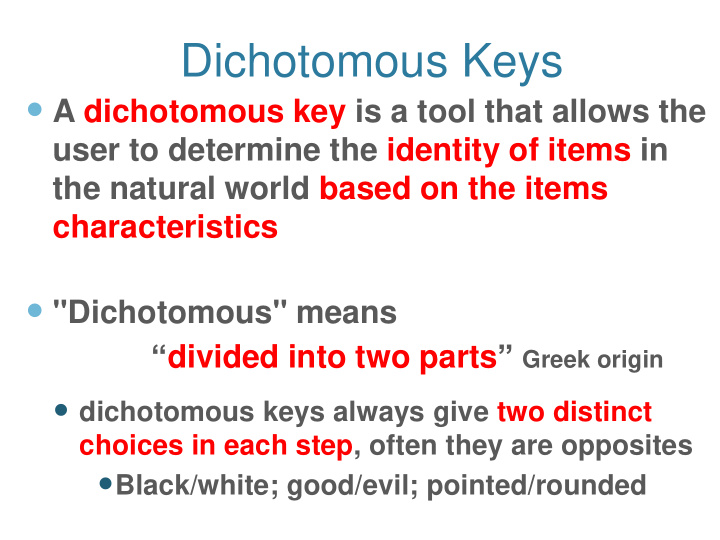



Dichotomous Keys A dichotomous key is a tool that allows the user to determine the identity of items in the natural world based on the items characteristics "Dichotomous" means “ divided into two parts ” Greek origin dichotomous keys always give two distinct choices in each step, often they are opposites Black/white; good/evil; pointed/rounded
How to use a Dichotomous Key? Here are creatures we don’t know! Lets choose one
How to use a Dichotomous Key? Choose only one creature at a time.
How to use a Dichotomous Key? Read steps 1a and 1b Decide which statement is true 1b is true
How to use a Dichotomous Key? Then follow the directions after that step.
How to use a Dichotomous Key? At choice 5, you make another dichotomous choice 5a is true
How to use a Dichotomous Key? Keep going until you come to a step that gives you the creature’s name. 6 a. The creature has one antennae Go to Step 7.
How to use a Dichotomous Key? Choose a new creature and start at step 1a and 1b again. Continue until you find the creature’s name. C Where do you start Again?
Then, find the names of all the creatures
What if I needed to make a key: - Start with the most obvious features of the item and move to more specific statements. - Remember, each statement must have 2 choices. - For example you might start by creating a dichotomous key to identify students in your class. Begin with very general statements: Is the student male or female? Does the student have blue eyes or brown eyes? Does the student wear glasses? Etc. You can set up your key as a flow chart, or as a grid. - Use constant characteristics rather than variable ones. (Flowers change with the seasons) - Use measurements rather than terms like "large" and "small". - Make the choice a positive one - something "is" instead of "is not". - If possible, start both choices of a pair with the same word or item. - the body is “round” vs the body is “square” - Finish the dichotomous key with a full description of the organism
Dichotomous key Another Example of a dichotomous key… 1 W ith flow er. A ngiosperm s W ithout flow er G o to 2 2 Seedless. G o to 3 Seed bearing G ym nosperm s 3 Plant body do not differentiated into root, G o to 4 stem and leaves. Plant body differentiated into root, stem and G o to 5 leaves 4 W ithout photosynthetic pigm ent. A lgae W ith chlorophyll or other photosynthetic Fungi pigm ent 5 N o vascular tissues. M osses W ith vascular tissues Fern
Dichotomous key the dichotomous key can also be expressed in a diagram form P lants W ith flow er W ithout flow er F low ering P lants N on-flow ering plants (A ngios perm) S eed-bearing S eedles s P lant body not P lant body differ entiated into differ entiated root, s tem and into s tem and leaves leaves W ith chlorophyll or W ithout phots y n- N o vas cular W ith vas cular other photos ynthetic thetic pigment tis s ues tis s ues pigment A lgae F ungi M os s es F erns G y mnos perms
Recommend
More recommend